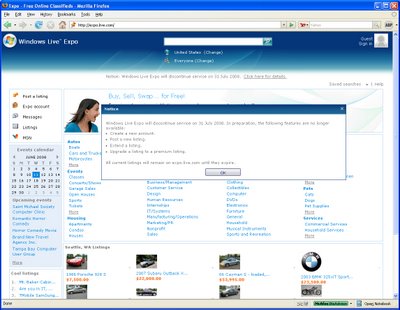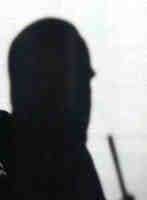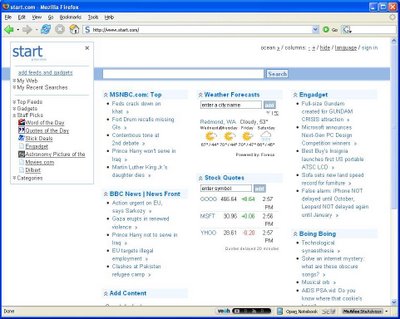 Well, aQuantive got snapped up by Microsoft today for $6 billion, and it's a development that is rocking the online marketing world. M&A fever in this sector has been superheated in the past few weeks, with Google announcing an acquisition of DoubleClick, WPP acquiring 24/7, and Yahoo acquiring Right Media.
Well, aQuantive got snapped up by Microsoft today for $6 billion, and it's a development that is rocking the online marketing world. M&A fever in this sector has been superheated in the past few weeks, with Google announcing an acquisition of DoubleClick, WPP acquiring 24/7, and Yahoo acquiring Right Media.
aQuantive is, of course, the corporate heir to pioneering Silicon Alley-based design firm Razorfish, which it acquired and later combined with a number of different properties which now constitute its core strengths. I'll leave the strategic discussion of what this all means for online advertising to others, because there are many robust discussions going on that can be referenced at TechMeme.com, and provide this interview, with original Razorfish employee Andreas Butzko, which originally ran on Ghost Site sin June of 2005.
Andreas Butzko is the curator of
The Razorfish Museum, a site which has preserved many important digital artifacts produced by Razorfish, New York's pioneering Web design and consulting company. Founded ten years ago by Jeff Dachis and Craig Kanarick, Razorfish was one of Silicon Alley's great success stories (it grew from a staff of two to almost two thousand in just a few years and was worth, at its peak, about $2 billion). Razorfish's early work also defined, beyond that of any other New York-based Web design company, the meaning of "cyber-cool."
In this interview, Mr. Butzko tells Ghost Sites what working at Razorfish was like in its prime, the fate that befell the company, and how The Razorfish Museum has helped link up Razorfish's widely-flung diaspora of former employees (at the high point of its global reach, Razorfish had offices in Amsterdam, Boston, Frankfurt, Helsinki, Los Angeles, Milan, Munich, New York, Oslo, San Francisco, Silicon Valley, Stockholm, and Tokyo).
Ghost Sites: What does Razorfish mean to you?
Andreas Butzko: It was the best time in my working life so far.
GS: When did you start the Razorfish Museum?
Andreas: The ex-Razorfish community website (
www.ex-razorfish.com) was started on March 3rd, 2001. The ex-Razorfish museum website (
www.razorfish-museum.org) was started on June 5th of that year.
GS: Why did you start it?
Andreas: The community site was started at a time when the Razorfish management, especially in Germany, had changed and a lot of people had left the company, due to the fact that the culture and working environment had been transformed.
Working at Razorfish was always more then "just work." Some "fish" thought it would be good to have the possibility of keeping in touch with each other, and maybe working together again after the Razorfish time and it was clear to everyone that the right tool for it was the Web. So a colleague of mine started developing the "museum" to share our memories about Razorfish and I started the community Web site to give everyone the opportunity to have a single point of contact with ex-fishes.
GS: You have a lot (1,168) of subscribers now. Are they all ex-Razorfish employees?
Andreas: Yes: nearly all are from the "original" Razorfish Inc. and some are from the successor companies like Avenue A | Razorfish or SBI/Razorfish, but all started at Razorfish Inc.
GS: Your museum is not open to the public. What would the public see were it to be able to take a look inside? Are there early examples of Razorfish projects there? Are these exhibits static mockups or fully-fledged functioning prototypes?
Andreas: The museum is not public, because we do not want to harm anyone's privacy. Inside the museum you will find a lot of pictures taken at several events (for example, Fishfry 1.0 - Las Vegas, December 1999) and other events. There are also pictures from daily office life and project work, starting in 1996, from all of Razorfish's offices around the world. In addition you will different "designs" from the old Razorfish, some advertising campaigns and several publications from Razorfish employees. Overall there are several thousand pictures in the museum.
GS: What can you tell me about your own experience at Razorfish? Was it a happy one?
Andreas: Yes, working at Razorfish during that time was something completely different from working at an "old economy" company. There was a "can do" spirit at Razorfish. Nothing was impossible. Everyone was working for the same objectives, from trainees all the way up to the CEO, and everyone was talking to each other. Communication was one of the great advantages of Razorfish and is still lacking in many other companies. Also our clients wanted to have "something new". Everything was allowed and we could try a lot, resulting in some great successes for our clients. But we were also given the freedom to make mistakes.
GS: Has anybody at Razorfish sent you feedback on the museum? What was their reaction?
Andreas: I got a lot of feedback. Most of my ex-colleagues told me that this is the most valuable service ever created by a fish ;-). But Razorfish in NYC tried to sue me for doing the website when I started it in 2001. I had to make some changes and state some policies to calm them. They also blocked the Web site to prevent their internal users from seeing it. So, the ex-Razorfish community was never actively supported by Razorfish Inc.
GS: What can you tell me about what went wrong at Razorfish? How could things have turned out better?
Andreas: This is something I could write a book about :-). Here are some bullet points:
- A management team that did not commit itself to the Razorfish culture and vision (starting with the acquisition of I-Cube).
- Too rapid growth of the company (from 500 to nearly 2,500 employees in 1 year)
- Bad acquisitions (for example, Medialab in Munich and I-Cube) of companies that were not worth the money.
- "Stakeholder thinking," not client thinking.
- Too much money for the management team without any regard to their actual business experience.
- A gold-rush mood, with every new manager wanted to become a millionaire in a year.
- No reward for doing great work, just for closing deals (which could not be delivered).
- In the beginning, people did overtime and stretched themselves because they believed they were part of something new. Later on, the management blackmailed the employees to do overtime and perform at lower salaries.
- Plus all the all other known problems of the New Economy (this book may only be available in German).
GS: Do you think that Razorfish has gotten a "bad rap" that is undeserved? Has it been lumped in with other "dot com disasters" unfairly?
Andreas: No, I think that all problems within Razorfish were self-made. As I said before, when new management started to try old school methods within the Razorfish culture, it began killing the special Razorfish culture, drowning the spirit and halting open communications. This was the beginning of the end.
For the new management, making money was much more important then having happy clients and employees or doing great work. Don't get me wrong; of course Razorfish had to be profitable, but not every manager needed to be a stock millionaire in a year so they could retire at 35. But that was the expectation among "old school" managers who entered the company. The company changed its focus from doing serious business to gambling. And the creative minds from the early days could not win against the "hardliners" from the old school.
GS: Do you think that the Razorfish Museum has been important as a way to connect ex-Razorfish employees?
Andreas: Yes, I have heard of regular meeting of ex-fish that still happen, for example, in London. These meetings are organized via the ex-Razorfish platform.
GS: Are there any happy reunion stories that you can tell me? Have ex-"fishes" been able to help each other find jobs or other support?
Andreas: There are job posting nearly every day. From fish-to-fish, but also from headhunters looking for talented people. For example, a lot ex-fish started to work as freelancers after their Razorfish time. On a project base, there were virtual teams built up which have found each other via the ex-Razorfish platform. The advantage of such teams is the same mind set, which helps them build teams quickly. Everyone knows what to expect from each other.
GS: Do you think that you're doing something important by saving the early days of Razorfish? If you hadn't acted, would important artifacts have been lost?
Andrea: Not really. In the digital world, the life time of a digital asset is very short by default.
GS: How much time do you think that you've put into the Museum?
Andreas: Developing it took just a few weeks.
GS: Does it take a lot of maintenance?
Andreas: Approximately 2 to 4 hours a week.
GS: What's next for the Razorfish Museum? What would you like to happen?
Right now, I will be happy if the ex-Razorfish community Web sites continue to be of use for the ex-fishes and survive for the next few years. I hope that a lot of ex-colleagues will get new jobs or other opportunities via the connections made on the ex-Razorfish website. So, from my point of view, the Razorfish community is still alive and hopefully will stay alive for a long time.
Labels: Advertising, aQuantive, Microsoft, Razorfish
 Nobody's asked for my comments on Jerry Seinfeld now shilling for Microsoft, but here they are anyway:
Nobody's asked for my comments on Jerry Seinfeld now shilling for Microsoft, but here they are anyway:





